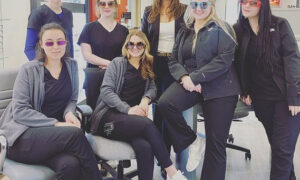
By Chad Fleming, OD, FAAO
Nov. 16, 2016
In optometry school, I worked as an optician and managed a 1,500 frame board. At the time, my wife who worked as a frame sales rep, has created a practice that is keenly aware of optical management, including how frames are priced and presented to patients.
We utilize 25-30 different brands of frames on the board. We have two locations, and our frames vary in each location to give an overall selection that allows for a high percentage of individuals to purchase glasses and not be wanting to go someplace else due to lack of selection. We offer approximately 750 frames at each location.
We look at the local market and utilize our business sense to price frames competitively and profitably. Unlike other retailers, opticals in OD offices have to factor in how the managed vision plans will compensate us and cover patients when a patient purchases frames.
Research Your Competition
Have one of your staff shop around locally, and collect pricing on various frame lines, so you can quickly determine the mark-up of other opticals in your area. As long as you are in the ballpark, +/- $15, your practice should not be losing patients to pricing. There are suggested manufacturer’s pricing on many of the frames, but we tend to ignore that, and have transitioned to a two-tier mark-up system. All frames are marked up by a multiple by one-of-two multiples, depending on the base frame price in Frames Data. This also allows our optical team to easily price frames within our practice management software since there is a multiple field that can be loaded.
I don’t worry too much of private practice competitors. There are many other good private practices in my city that do a great job of taking care of patients, and we have found them to be very similar in pricing of frames. What I have my optical keep an eye on is the large commercial establishments. There are two questions we ask ourselves: Are we offering frame lines that they carry, and if so, are our prices relatively competitive with them?
Create Multi-Tiered Pricing
We offer three tiers of frames in our optical. This allows our staff to learn the differences in quality, and why frames are priced differently, so they can quickly overview with patients the benefits of higher-priced frames and the value of lower-cost ones. Our lowest-cost frames will be in our package pricing of SV + AR + Poly + Frame for $99. The frame is no charge to the patient when bought within this pricing structure. The highest-end frames in our optical price out at about $450.
Consider Your Practice’s Demographics
We serve many blue collar workers in our city. They tend to want a good quality value-driven pair of glasses. This does not mean that patients do not look for the higher-end brand names, but the majority of our patients are value driven, keeping quality in mind over the name on the frame. We do sell many of the higher-end frames, but relative to opticals located in other parts of the city, probably a lower proportion of high-end frames. Most of our frames sold price out from $150 to $250.
Determine How (if at all) to Mark Pricing
We use Letratag, which is a small transparent sticker that goes on the lens and has the price tag on it. This allows for patients to try on frames without an attachment on the temple that gets in the way. Patients should know the price of frames when they are looking around.
Train Staff How to Present Pricing
We train our staff to present frames in three tiers based on pricing. Many of our patients have some form of a managed vision benefit. Before discussing the benefit, our staff are trained to walk each patient through the three tiers of frames, including the benefits of each tier, and the value included in the pricing. This allows for patients to be fully educated about why they would want to spend more on frames than just what their managed plan covers. It usually works well because patients tend to buy the least expensive frame if they do not understand the value of investing in better quality frames.
We conduct training “camps” that include role-playing of how staff can best have this discussion with patients.
Don’t Prejudge Patient Buying Power
A mistake our practice has made in the past, and continues to make on occasion, is thinking that we know what the patient wants. The book, “Blink,” by Malcom Gladwell, illustrates the mistake we used to frequently make. At first “blink” we make judgements about our patients that impact how we interact with them. We allow our subconscious, snap judgements of people to tailor the way we present frames and ophthalmic lenses to patients.
We should assume that every patient wants to be aware of all the frame options available in our office, from inexpensive to high end.
Chad Fleming, OD, FAAO, is a partner with Wichita Optometry, P. A. in Wichita, Kan. To contact: optometryceo@gmail.com



























